Vertical Structures Associated with Orographic Precipitation during Warm Season in the Sichuan Basin and Its Surrounding Areas at Different Altitudes from 8-Year GPM DPR Observations
Abstract
:1. Introduction
2. Data and Methods
3. Results
3.1. Vertical Distribution Characteristics of Radar Reflectivity Factor
3.2. Vertical Distribution Characteristics of Mass-Weighted Mean Raindrop Diameter
3.3. Vertical Distribution Characteristics of dBNw
3.4. Distribution Characteristics of Storm Top Altitude and Water Vapor
4. Discussion
5. Conclusions
- The FzH of the two types of heavy precipitation is hardly affected by topography, except for heavy CP over mountains. The mean Ze profiles of SP are significantly bent near FzH, which is different from that of CP.
- For the same types of terrain, the Dm horizontal distribution domain, vertical distribution domain, and the maximum Dm of the horizontal distribution domain of heavy CP are all larger than those of heavy SP. With the increase of elevation, the horizontal distribution domain of Dm of the two types of heavy precipitation increases, while the vertical distribution domain of Dm decreases. For heavy CP, as elevation increases, the occurrence probability of larger precipitation particles (Dm ≥ 2.6 mm) increases as well as Dm horizontal distribution domain, which is probably related to the strong updraft rendered by topography, while the seeder-feeder mechanism may also enhance particle growth mechanism. For heavy SP, the occurrence probability of medium raindrops (Dm in 1.3–1.6 mm) below FzH over high mountains is higher than those over plains. This is because water vapor over high mountains is more sufficient, the underlying surface is closer to FzH, and the updraft is more likely to transport water vapor to FzH, which makes snow and graupel particles above FzH grow rapidly, and thus it is easier to form larger raindrops. For heavy precipitation, the higher the elevation, the larger the Dm above 10 km altitude.
- The mean dBNw profiles of the two types of precipitation overall increase with the decreases of altitude. For heavy CP, the dBNw high frequency area of plains is more concentrated than that of mountains and high mountains, while the situation of heavy SP is opposite. Above 10 km altitude, compared with plains, the precipitation particles of heavy precipitation over high mountains have the characteristics of lower number concentration and larger scale.
- In the same terrain, overall, STA of heavy CP is higher than heavy SP. The distribution characteristics of STA of the two types of heavy precipitation are consistent, and STA of plain is generally higher than that of mountains and high mountains. There is a positive linear correlation between STA and the near-surface Dm for heavy precipitation (excluding heavy SP over plains and high mountains), and the correlation is most significant for heavy CP over mountainous. The slope of the linear regression equation of heavy CP over high mountainous terrain is the largest, followed by mountains and plains, indicating that when precipitation particles grow to the same size over different terrains, the STA of high mountainous is the smallest, while that of plains is the largest.
- For heavy precipitation, the total distribution of water vapor from ground to FzH is the most sufficient over plains, followed by over the mountains, and the smallest over high mountains, which is caused by the difficulty of transporting water vapor to mountains and high mountains areas due to the effect of altitude and terrain barrier. For heavy precipitation (excluding heavy precipitation over high mountains), there is also a positive linear correlation between STA and the total water vapor in the altitude layer from surface to FzH, and the correlation of heavy SP over plains is the most significant.
Author Contributions
Funding
Data Availability Statement
Acknowledgments
Conflicts of Interest
References
- Robert, A., Jr. Houze Cloud Clusters and Large-Scale Vertical Motions in the Tropics. J. Meteorol. Soc. Jpn. Ser. II 1982, 60, 396–410. [Google Scholar] [CrossRef]
- Houze, R.A., Jr. Mesoscale Convective Systems. Rev. Geophys. 2004, 42, RG4003. [Google Scholar] [CrossRef]
- Cifelli, R.; Rutledge, S.A. Vertical Motion, Diabatic Heating, and Rainfall Characteristics in North Australia Convective Systems. Q. J. R. Meteorol. Soc. 1998, 124, 1133–1162. [Google Scholar] [CrossRef]
- Hobbs, P.V. Research on Clouds and Precipitation: Past, Present, and Future, Part I. Bull. Am. Meteorol. Soc. 1989, 70, 282–285. [Google Scholar] [CrossRef]
- Zipser, E.J.; Lutz, K.R. The Vertical Profile of Radar Reflectivity of Convective Cells: A Strong Indicator of Storm Intensity and Lightning Probability? Mon. Weather. Rev. 1994, 122, 1751–1759. [Google Scholar] [CrossRef]
- Pruppacher, H.R.; Klett, J.D. Microstructure of Atmospheric Clouds and Precipitation. In Microphysics of Clouds and Precipitation; Springer: Dordrecht, The Netherlands, 2010; pp. 10–73. ISBN 978-0-306-48100-0. [Google Scholar]
- Chang, W.-Y.; Lee, W.-C.; Liou, Y.-C. The Kinematic and Microphysical Characteristics and Associated Precipitation Efficiency of Subtropical Convection during SoWMEX/TiMREX. Mon. Weather. Rev. 2015, 143, 317–340. [Google Scholar] [CrossRef]
- Wu, G.; Liu, Y.; Zhang, Q.; Duan, A.; Wang, T.; Wan, R.; Liu, X.; Li, W.; Wang, Z.; Liang, X. The Influence of Mechanical and Thermal Forcing by the Tibetan Plateau on Asian Climate. J. Hydrometeorol. 2007, 8, 770–789. [Google Scholar] [CrossRef]
- Boos, W.R.; Kuang, Z. Dominant Control of the South Asian Monsoon by Orographic Insulation versus Plateau Heating. Nature 2010, 463, 218–222. [Google Scholar] [CrossRef]
- Zhang, A.; Fu, Y.; Chen, Y.; Liu, G.; Zhang, X. Impact of the Surface Wind Flow on Precipitation Characteristics over the Southern Himalayas: GPM Observations. Atmos. Res. 2018, 202, 10–22. [Google Scholar] [CrossRef]
- Wen, Y.; Kirstetter, P.; Hong, Y.; Gourley, J.J.; Cao, Q.; Zhang, J.; Flamig, Z.; Xue, X. Evaluation of a Method to Enhance Real-Time, Ground Radar–Based Rainfall Estimates Using Climatological Profiles of Reflectivity from Space. J. Hydrometeorol. 2016, 17, 761–775. [Google Scholar] [CrossRef]
- Hou, A.Y.; Kakar, R.K.; Neeck, S.; Azarbarzin, A.A.; Kummerow, C.D.; Kojima, M.; Oki, R.; Nakamura, K.; Iguchi, T. The Global Precipitation Measurement Mission. Bull. Am. Meteorol. Soc. 2014, 95, 701–722. [Google Scholar] [CrossRef]
- Mugnai, A.; Di Michele, S.; Smith, E.; Baordo, F.; Bauer, P.; Bizzarri, B.; Joe, P.; Kidd, C.; Marzano, F.; Tassa, A.; et al. Snowfall Measurements by Proposed European GPM Mission. In Advances in Global Change Research; Springer: Dordrecht, The Netherlands, 2007; Volume 28, pp. 655–674. ISBN 978-1-4020-5834-9. [Google Scholar]
- Kulie, M.; Bennartz, R. Utilizing Spaceborne Radars to Retrieve Dry Snowfall. J. Appl. Meteorol. Climatol. 2009, 48, 2564–2580. [Google Scholar] [CrossRef]
- Fu, Y. Satellite-borne active and passive instruments for remote sensing of heavy rain in China:A review. Torrential Rain Disasters 2019, 38, 554–563. (In Chinese) [Google Scholar] [CrossRef]
- Liao, L.; Meneghini, R. Physical Evaluation of GPM DPR Single- and Dual-Wavelength Algorithms. J. Atmos. Ocean. Technol. 2019, 36, 883–902. [Google Scholar] [CrossRef] [PubMed]
- Jin, X.; Shao, H.; Zhang, C.; Yan, Y. The Applicability Evaluation of Three Satellite Products in Tianshan Mountains. J. Nat. Resour. 2016, 31, 2074–2085. (In Chinese) [Google Scholar] [CrossRef]
- Zhang, A. Structural Features of Precipitating Clouds observed by Geostationary Satellite and Dual-frequency Radar. Ph.D. Thesis, University of Science and Technology of China, Anhui, China, 2019. [Google Scholar]
- Lasser, M.O.S.; Foelsche, U. Evaluation of GPM-DPR Precipitation Estimates with WegenerNet Gauge Data. Atmos. Meas. Tech. 2019, 12, 5055–5070. [Google Scholar] [CrossRef]
- Sun, Y.; Dong, X.; Cui, W.; Zhou, Z.; Fu, Z.; Zhou, L.; Deng, Y.; Cui, C. Vertical Structures of Typical Meiyu Precipitation Events Retrieved From GPM-DPR. J. Geophys. Res. Atmos. 2020, 125, e2019JD031466. [Google Scholar] [CrossRef]
- Li, J.; Zheng, J.; Liu, Y.; Cheng, Z.; He, J.; Ren, T.; Chen, S. A Study on Vertical Structure and Macro- to Micro-Characteristics and Differences of Precipitation in Sichuan Basin and the Surrounding Areas. Acta Meteorol. Sin. 2022, 80, 205–223. (In Chinese) [Google Scholar] [CrossRef]
- Radhakrishna, B.; Saikranthi, K.; Rao, T.N. Regional Differences in Raindrop Size Distribution within Indian Subcontinent and Adjoining Seas as Inferred from Global Precipitation Measurement Dual-Frequency Precipitation Radar. J. Meteorol. Soc. Jpn. Ser. II 2020, 98, 573–584. [Google Scholar] [CrossRef]
- Verma, A.K.; Jha, K.K. Rain Drop Size Distribution Model for Indian Climate. Indian J. Radio Space Phys. 1996, 25, 15–21. [Google Scholar]
- Sasi Kumar, V.; Sampath, S.; Vinayak, P.V.S.S.K.; Harikumar, R. Rainfall Intensity Characteristics at Coastal and High Altitude Stations in Kerala. J. Earth Syst. Sci. 2007, 116, 451–463. [Google Scholar] [CrossRef] [Green Version]
- Seela, B.K.; Janapati, J.; Lin, P.-L.; Reddy, K.K.; Shirooka, R.; Wang, P.K. A Comparison Study of Summer Season Raindrop Size Distribution Between Palau and Taiwan, Two Islands in Western Pacific. J. Geophys. Res. Atmos. 2017, 122, 11787–11805. [Google Scholar] [CrossRef]
- Harikumar, R. Orographic Effect on Tropical Rain Physics in the Asian Monsoon Region. Atmos. Sci. Lett. 2016, 17, 556–563. [Google Scholar] [CrossRef]
- Zwiebel, J.; Van Baelen, J.; Anquetin, S.; Pointin, Y.; Boudevillain, B. Impacts of Orography and Rain Intensity on Rainfall Structure. The Case of the HyMeX IOP7a Event. Q. J. R. Meteorol. Soc. 2016, 142, 310–319. [Google Scholar] [CrossRef]
- Awaka, J.; Iguchi, T.; Okamoto, K. Early Results on Rain Type Classification by the Tropical Rainfall Measuring Mission (TRMM) Precipitation Radar. In Proceedings of the 8th URSI Commission F Triennial Open Symposium on Wave Propagation and Remote Sensing, Aveiro, Portugal, 22–25 September 1998; pp. 143–146. [Google Scholar]
- Awaka, J.; Iguchi, T.; Okamoto, K.; Trmm, P.R. Standard Algorithm 2A23 and Its Performance on Bright Band Detection. J. Meteorol. Soc. Jpn. Ser. II 2009, 87A, 31–52. [Google Scholar] [CrossRef]
- Le, M.; Chandrasekar, V. Precipitation Type Classification Method for Dual-Frequency Precipitation Radar (DPR) Onboard the GPM. IEEE Trans. Geosci. Remote Sens. 2013, 51, 1784–1790. [Google Scholar] [CrossRef]
- Le, M.; Chandrasekar, V. Hydrometeor Profile Characterization Method for Dual-Frequency Precipitation Radar Onboard the GPM. IEEE Trans. Geosci. Remote Sens. 2013, 51, 3648–3658. [Google Scholar] [CrossRef]
- Fan, J.; Zhang, Z.; Li, L. Mountain Demarcation and Mountainous Area Divisions of Sichuan Province. Geogr. Res. 2015, 34, 65–73. (In Chinese) [Google Scholar] [CrossRef]
- Gao, X. The Subjective and Objective Classification of Geomorphologic Forms. J. Mt. Sci. 2004, 22, 261–266. (In Chinese) [Google Scholar] [CrossRef]
- Zhong, J.; Lu, T. Optimal Statistical Unit for Relief Amplitude in Southwestern China. Bull. Soil Water Conserv. 2018, 38, 175–181,186. (In Chinese) [Google Scholar] [CrossRef]
- Yang, B. The Research of Mountains Ontology and Digital Classification in the framework of “Digital Mountains”—A Case Study in Sichuan Province. Ph.D. Thesis, Chengdu University of Technology, Sichuan, China, 2009. [Google Scholar]
- Yuter, S.E.; Houze, R.A. Three-Dimensional Kinematic and Microphysical Evolution of Florida Cumulonimbus. Part I: Spatial Distribution of Updrafts, Downdrafts, and Precipitation. Mon. Weather. Rev. 1995, 123, 1921–1940. [Google Scholar] [CrossRef]
- Zhang, A.; Chen, Y.; Zhang, X.; Zhang, Q.; Fu, Y. Structure of Cyclonic Precipitation in the Northern Pacific Storm Track Measured by GPM DPR. J. Hydrometeorol. 2020, 21, 227–240. [Google Scholar] [CrossRef]
- Houze, R.A., Jr.; Wilton, D.C.; Smull, B.F. Monsoon Convection in the Himalayan Region as Seen by the TRMM Precipitation Radar. Q. J. R. Meteorol. Soc. 2007, 133, 1389–1411. [Google Scholar] [CrossRef]
- Chen, B.; Gao, W.; Zhou, X. Synoptic Characteristic Analysis of Short-time Hard Rain in Southwest Sichuan Basin. Plateau Mt. Meteorol. Res. 2016, 36, 14–20. (In Chinese) [Google Scholar]
- Cao, Q.; Hong, Y.; Gourley, J.J.; Qi, Y.; Zhang, J.; Wen, Y.; Kirstetter, P.-E. Statistical and Physical Analysis of the Vertical Structure of Precipitation in the Mountainous West Region of the United States Using 11+ Years of Spaceborne Observations from TRMM Precipitation Radar. J. Appl. Meteorol. Climatol. 2013, 52, 408–424. [Google Scholar] [CrossRef]
- Sánchez-Diezma, R.; Zawadzki, I.; Sempere-Torres, D. Identification of the Bright Band through the Analysis of Volumetric Radar Data. J. Geophys. Res. Atmos. 2000, 105, 2225–2236. [Google Scholar] [CrossRef]
- Fu, Y.; Feng, J.; Zhu, H.; Li, R.; Liu, D. Structures of a thermal convective precipitation system happened in controlling of the western subtropical pacific high. Acta Meteorol. Sin. 2005, 63, 750–761. (In Chinese) [Google Scholar] [CrossRef]
- Fu, Y.; Cao, A.; Li, T.; Feng, S.; Zheng, Y.; Liu, Y.; Zhang, A. Climatic Characteristics of the Storm Top Altitude for the Convective and Stratiform Precipitation in Summer Asia Based on Measurements of the TRMM Precipitation Radar. Acta Meteorol. Sin. 2012, 70, 436–451. (In Chinese) [Google Scholar] [CrossRef]
- Fu, Y.; Feng, J.; Zhu, H.; Li, R.; Liu, D. Precipitation Structures of a Thermal Convective System Happened in the Central Western Subtropical Pacific Anticyclone. J. Meteorol. Res. 2006, 20, 232–243. [Google Scholar]
- Yan, Y.-F.; Wang, X.-C.; Liu, Y.-M. Cloud Vertical Structures Associated with Precipitation Magnitudes over the Tibetan Plateau and Its Neighboring Regions. Atmos. Ocean. Sci. Lett. 2018, 11, 44–53. [Google Scholar] [CrossRef]
- Wilson, A.M.; Barros, A.P. An Investigation of Warm Rainfall Microphysics in the Southern Appalachians: Orographic Enhancement via Low-Level Seeder–Feeder Interactions. J. Atmos. Sci. 2014, 71, 1783–1805. [Google Scholar] [CrossRef]

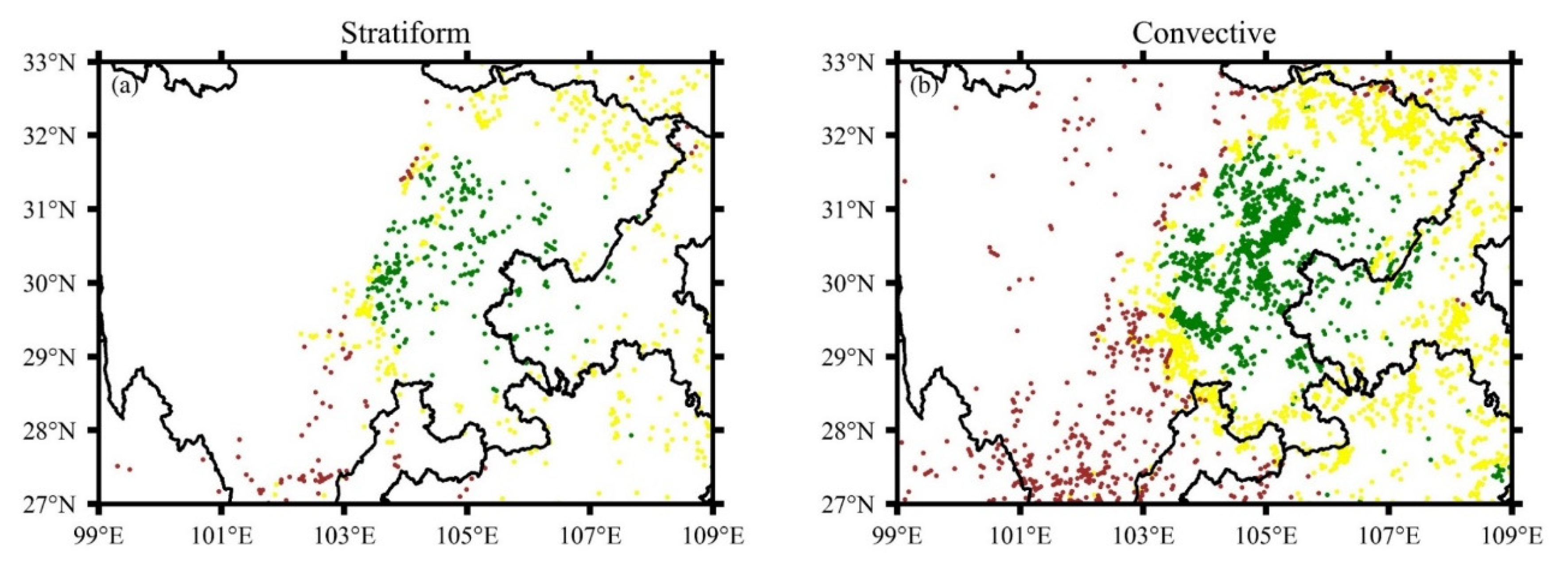


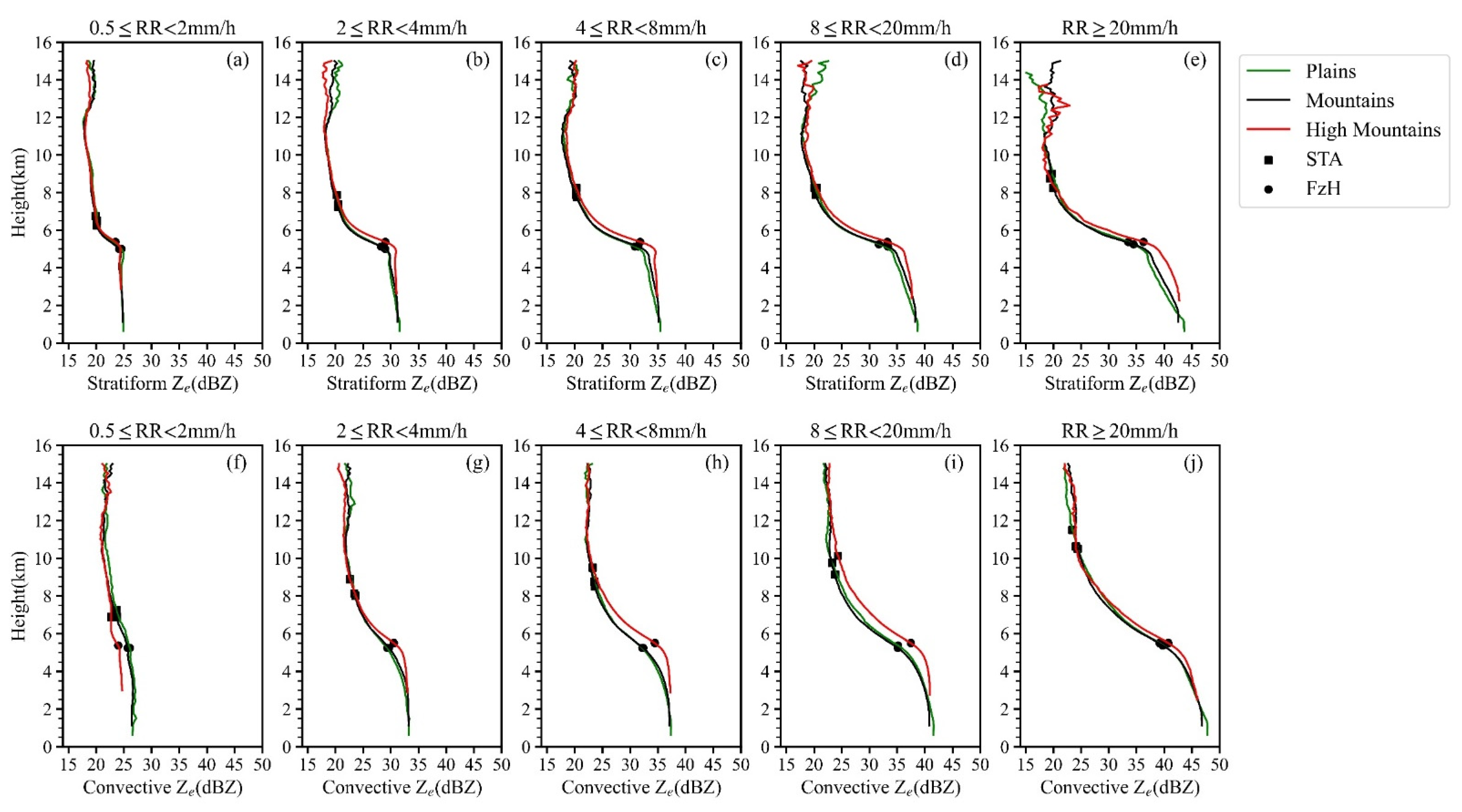
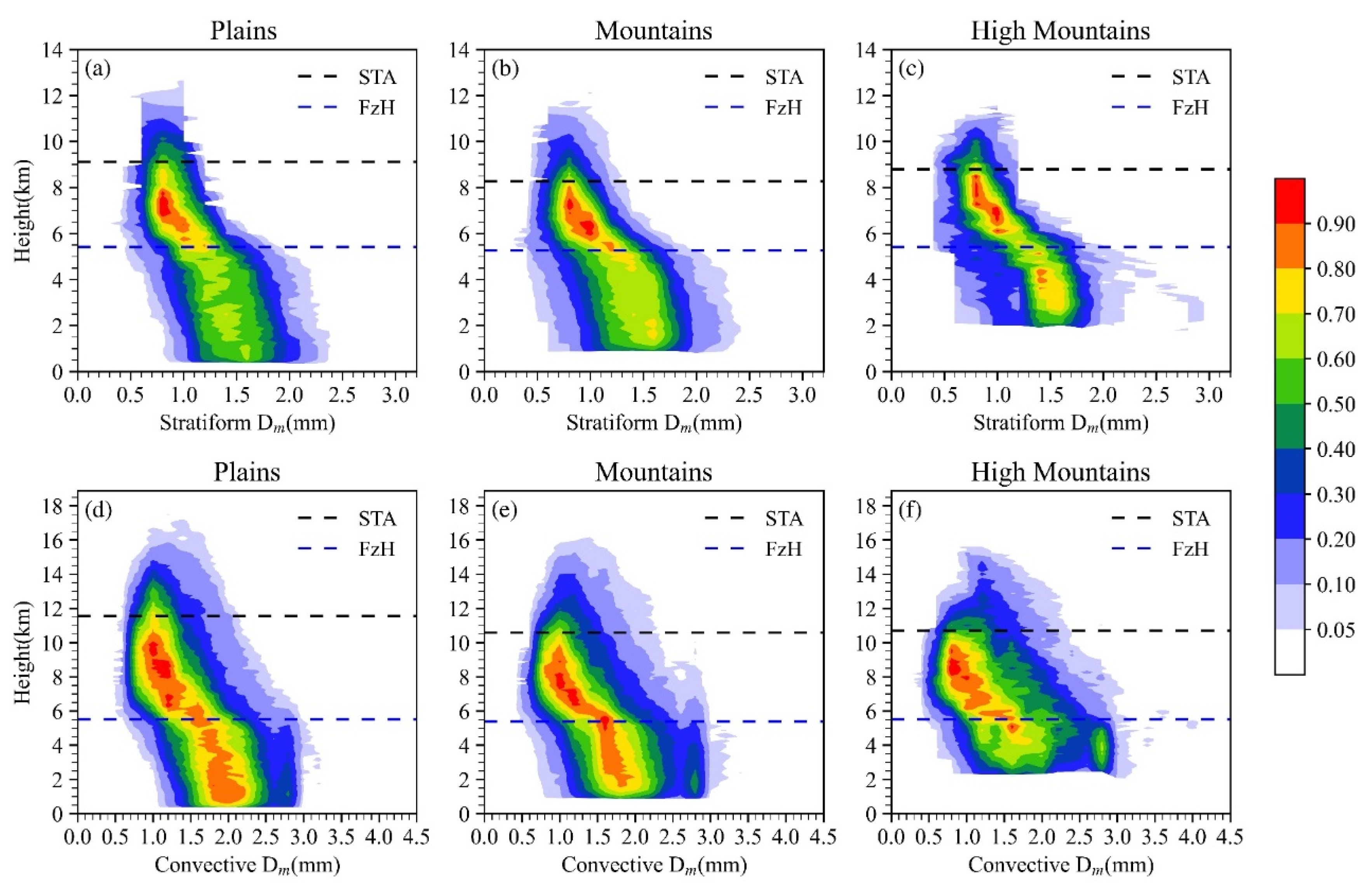
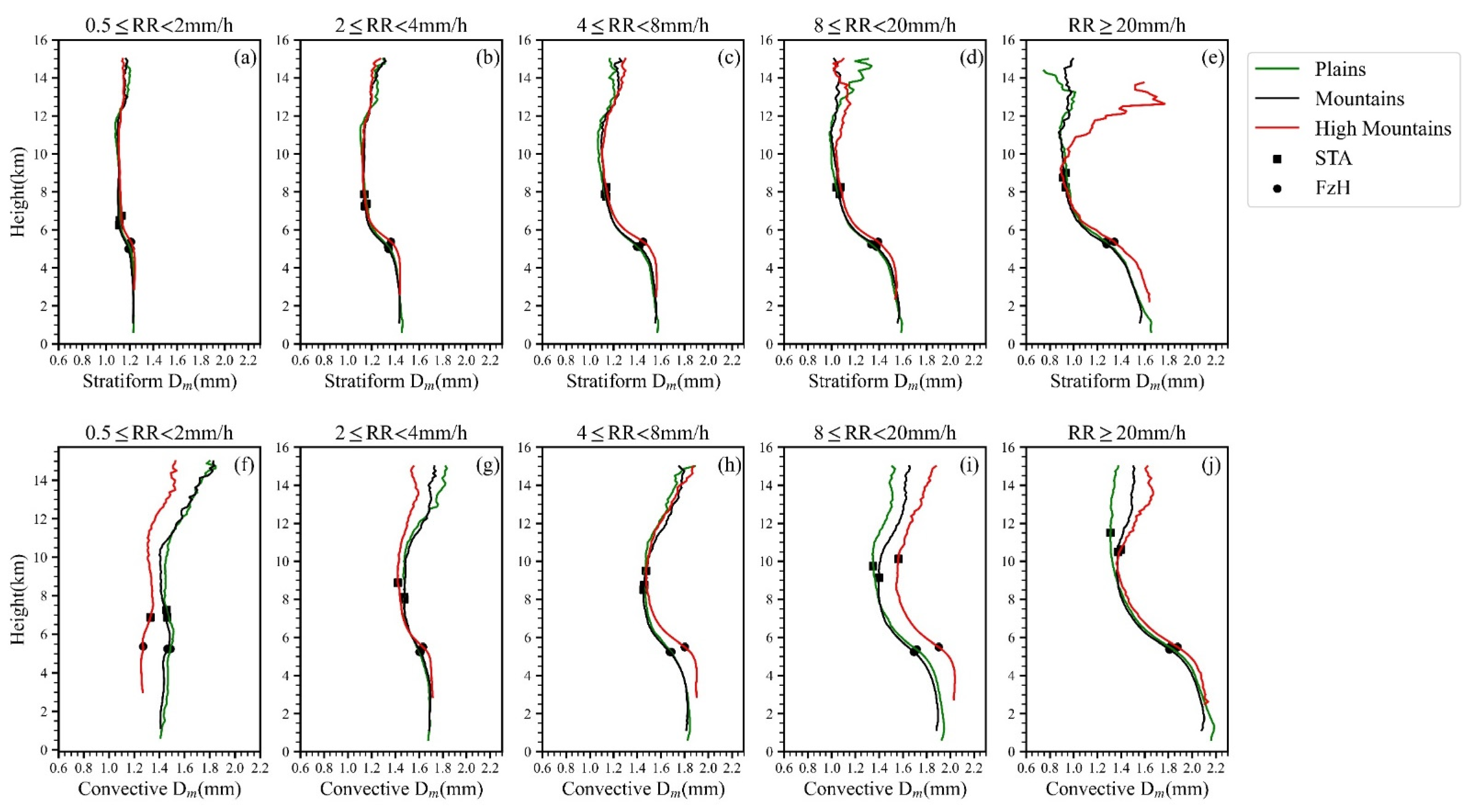
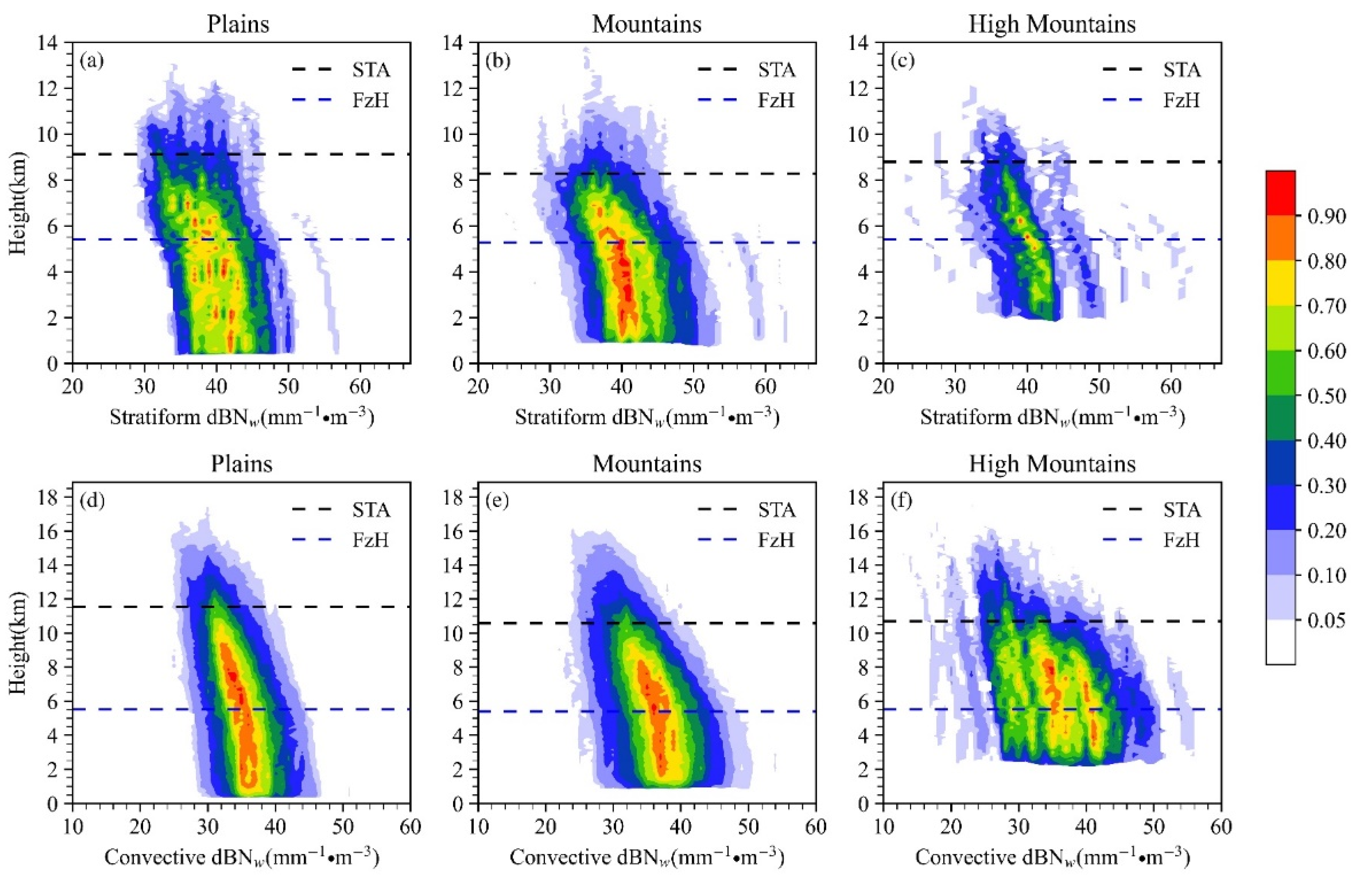

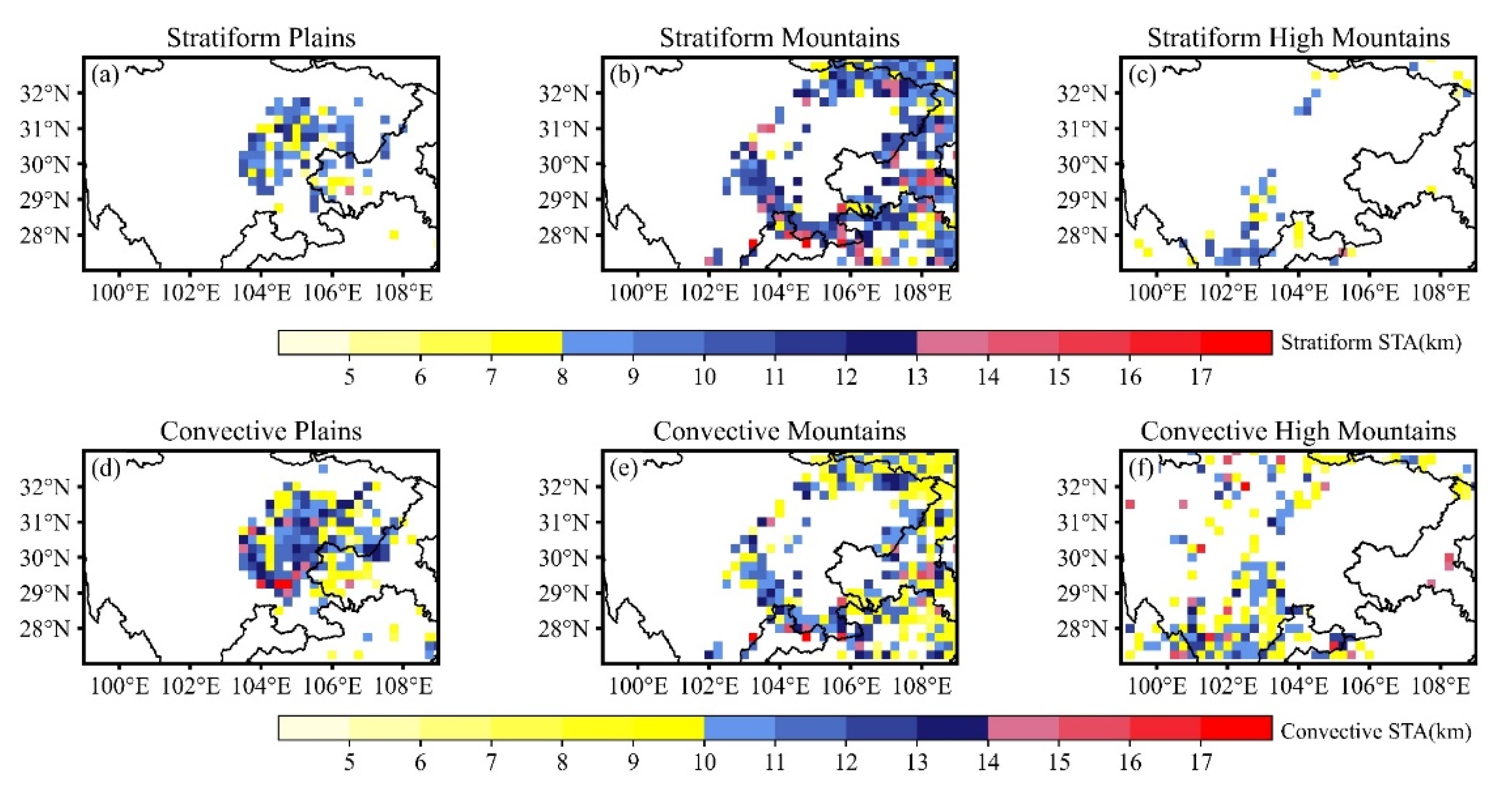
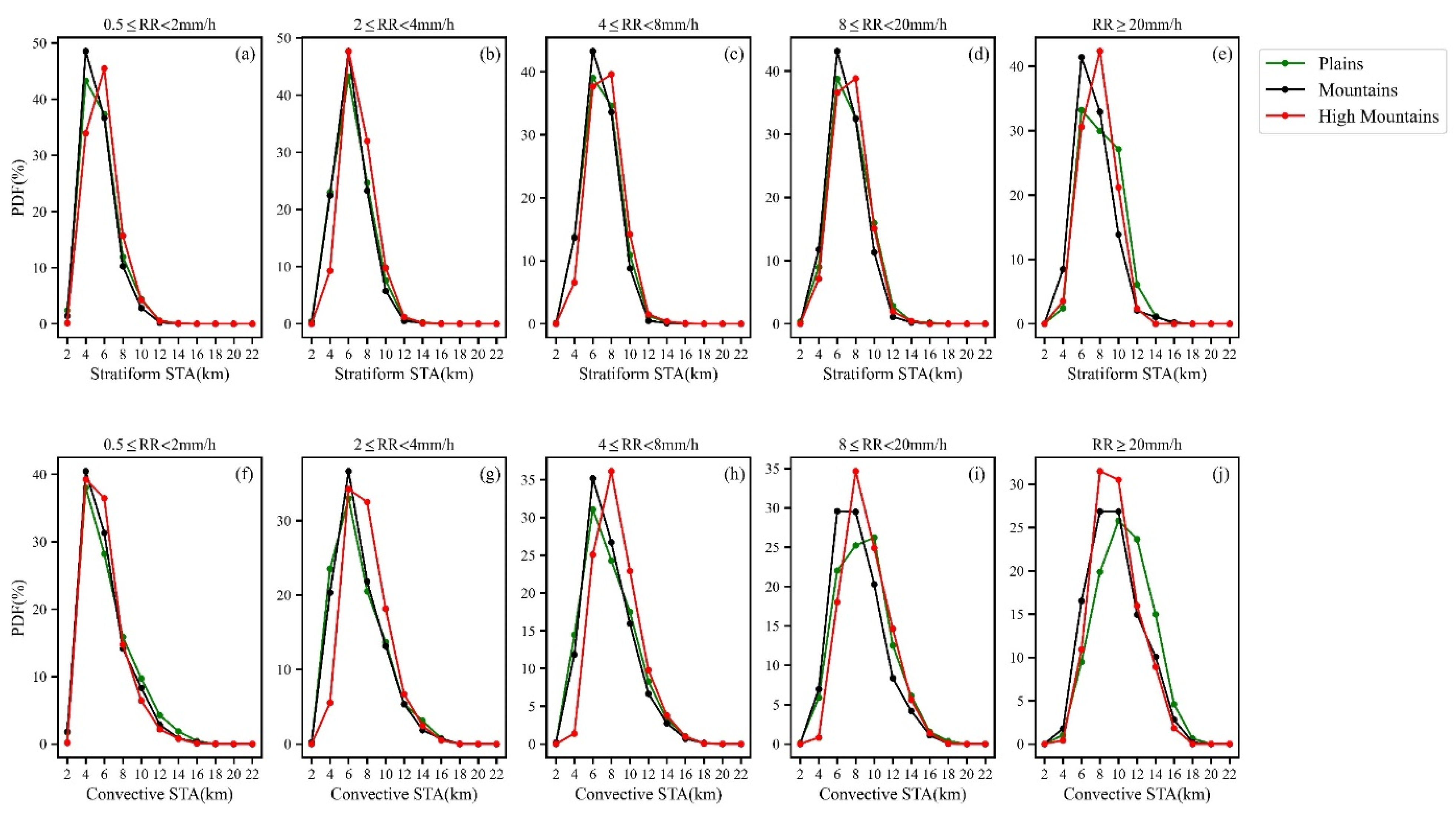
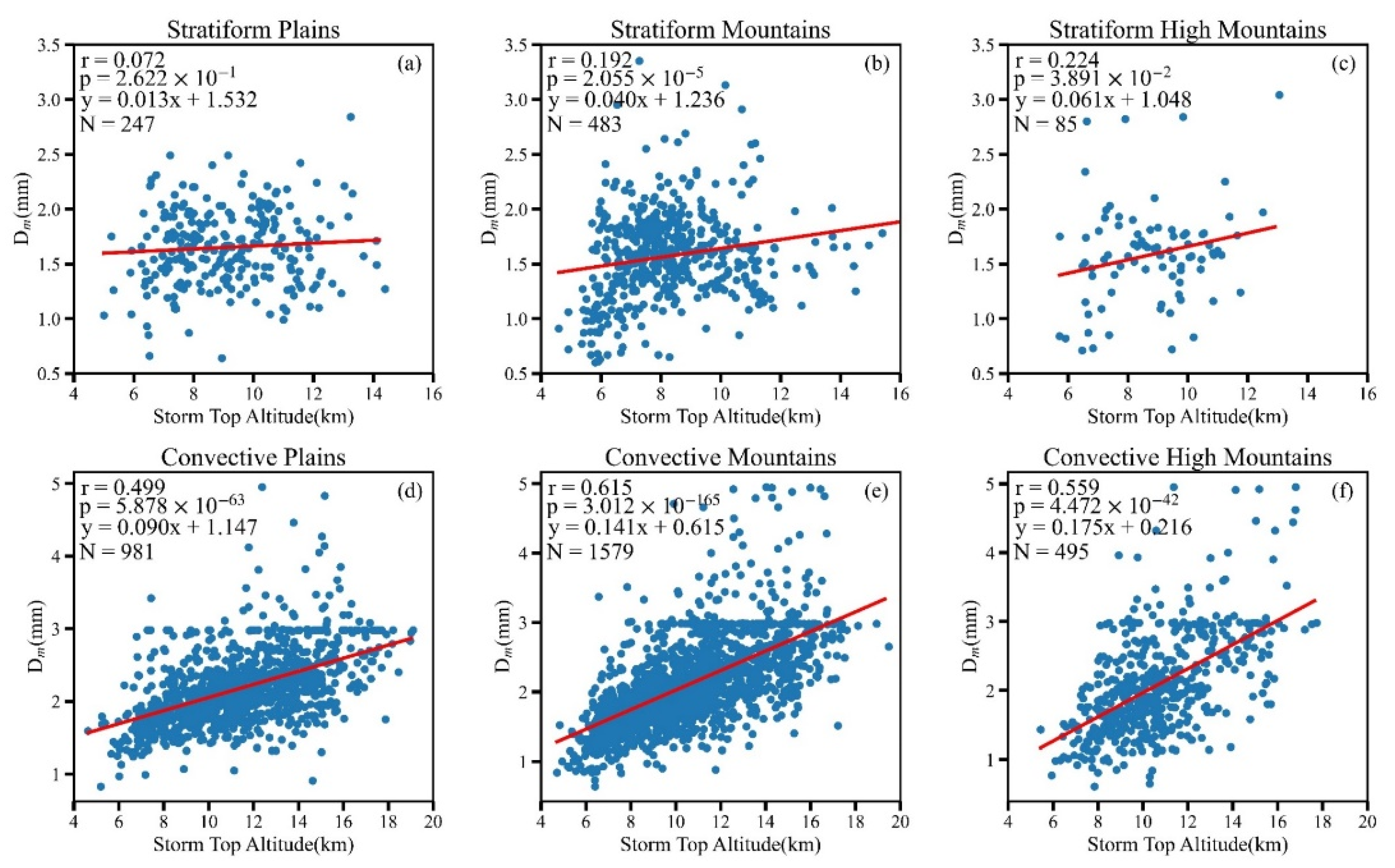


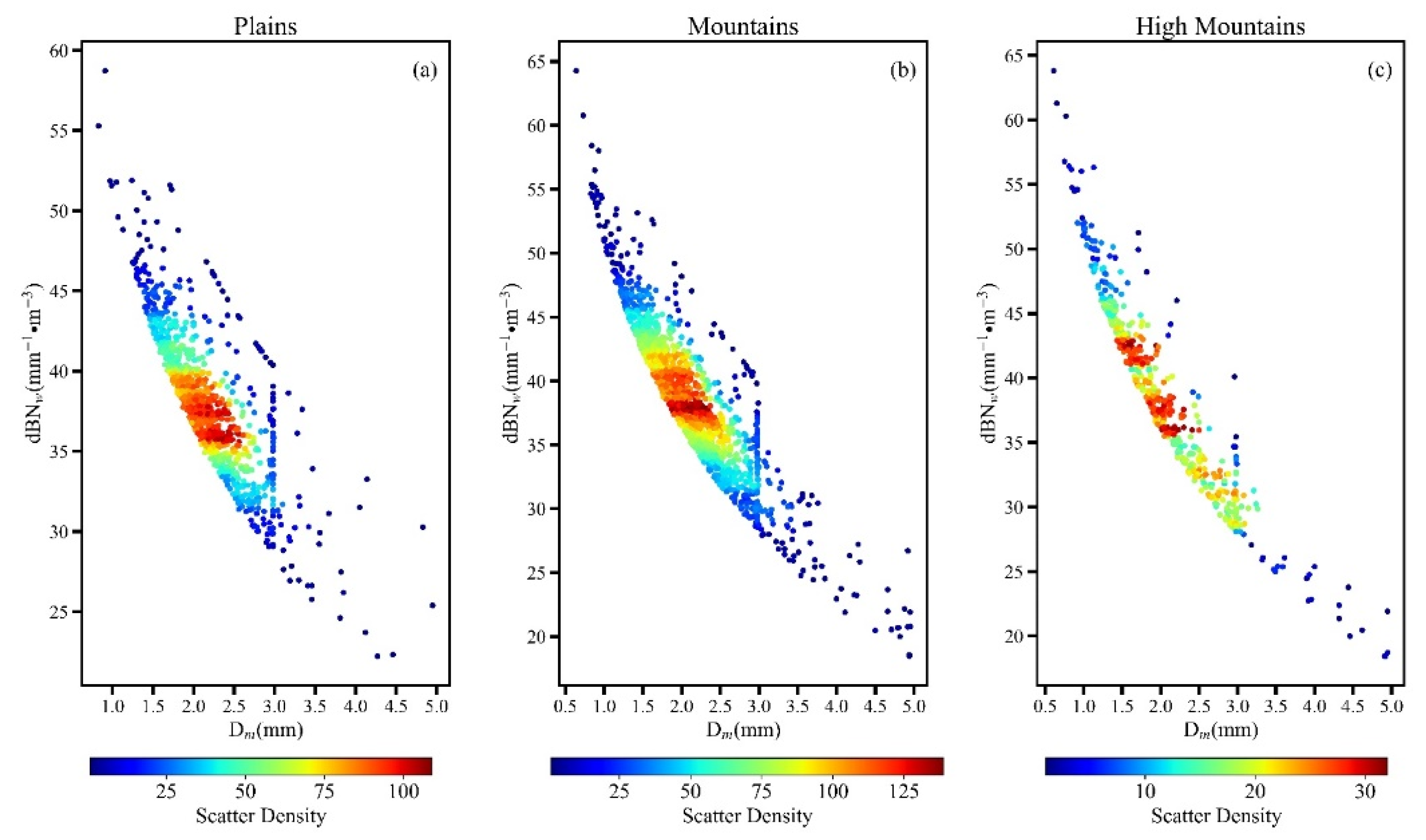
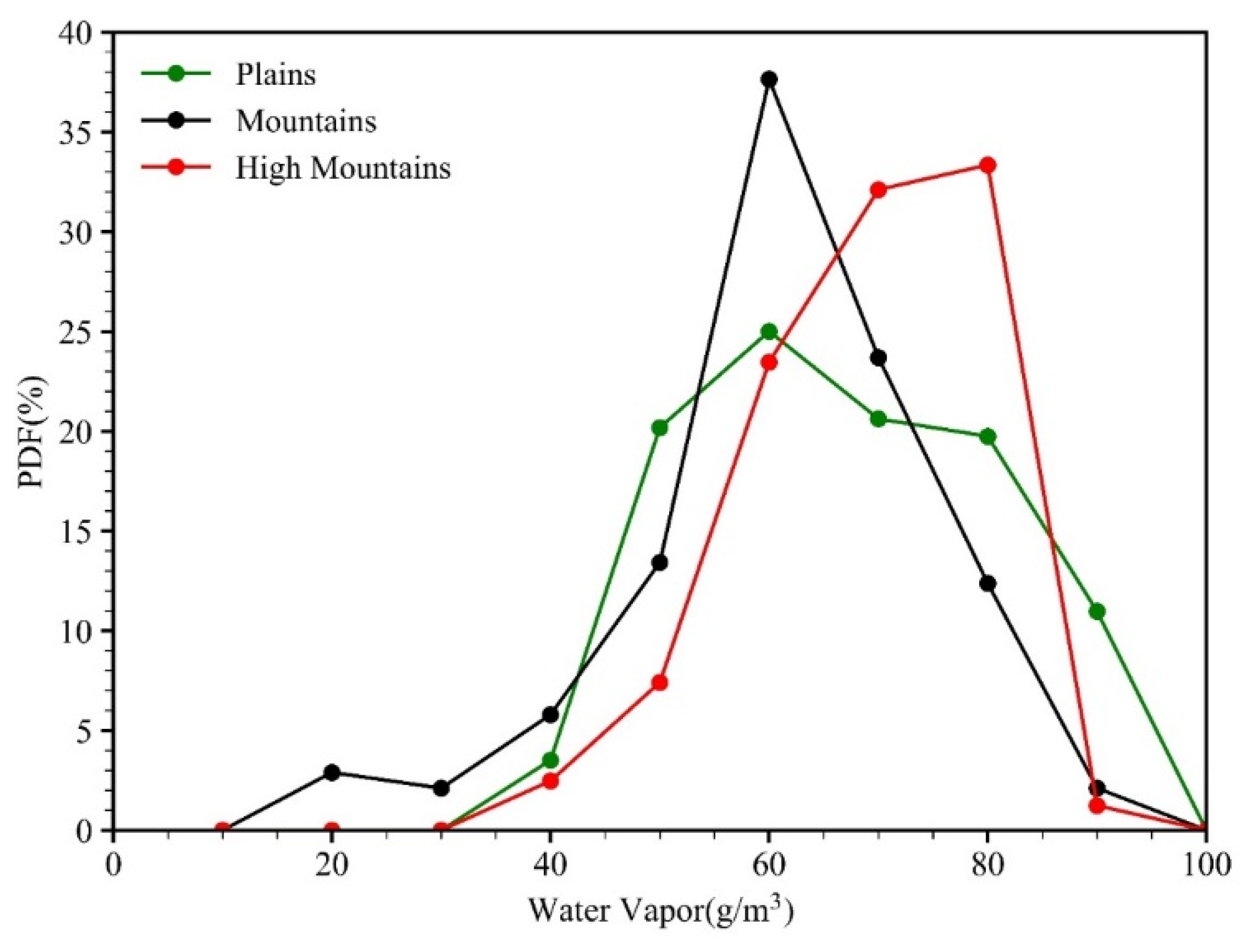
| RR (mm/h) | Plain | Mountain | High Mountain |
|---|---|---|---|
| 0.5 ≤ RR < 2 | 2186 (32,530) | 4616 (72,504) | 6646 (65,973) |
| 2 ≤ RR < 4 | 2031 (10,851) | 4146 (25,204) | 3885 (14,688) |
| 4 ≤ RR < 8 | 1985 (5301) | 4263 (12,772) | 3481 (5545) |
| 8 ≤ RR < 20 | 1685 (1674) | 3530 (3813) | 2126 (1121) |
| RR ≥ 20 | 981 (247) | 1579 (483) | 495 (85) |
| RR (mm/h) | 0.5 ≤ RR < 2 | 2 ≤ RR < 4 | 4 ≤ RR < 8 | 8 ≤ RR < 20 | RR ≥ 20 |
|---|---|---|---|---|---|
| Shallow convective (stratiform) of plains | 15.2% (15.0%) | 5.8% (5.4%) | 3.7% (2.7%) | 1.2% (1.5%) | 0.1% (0.0%) |
| Shallow convective (stratiform) of mountains | 17.4% (15.3%) | 5.1% (4.0%) | 2.4% (1.9%) | 0.8% (1.5%) | 0.2% (0.6%) |
| Shallow convective (stratiform) of high mountains | 7.9% (4.6%) | 0.5% (0.5%) | 0.1% (0.2%) | 0.0% (0.7%) | 0.0% (0.0%) |
| Moderate convective (stratiform) of plains | 68.6% (68.0%) | 71.3% (61.2%) | 66.3% (50.2%) | 52.0% (46.6%) | 30.3% (35.6%) |
| Moderate convective (stratiform) of mountains | 70.3% (71.3%) | 73.9% (66.3%) | 71.5% (55.1%) | 65.2% (53.4%) | 45.0% (49.3%) |
| Moderate convective (stratiform) of high mountains | 82.7% (74.9%) | 71.8% (56.4%) | 62.5% (44.0%) | 53.4% (43.0%) | 42.8% (34.1%) |
| Deep convective (stratiform) of plains | 16.2% (17.0%) | 22.9% (33.4%) | 30.0% (47.1%) | 46.8% (51.9%) | 69.6% (64.4%) |
| Deep convective (stratiform) of mountains | 12.3% (13.4%) | 21.0% (29.7%) | 26.1% (43.0%) | 34.0% (45.1%) | 54.8% (50.1%) |
| Deep convective (stratiform) of high mountains | 9.4% (20.5%) | 27.7% (43.1%) | 37.4% (55.8%) | 46.5% (56.3%) | 57.2% (65.9%) |
Publisher’s Note: MDPI stays neutral with regard to jurisdictional claims in published maps and institutional affiliations. |
© 2022 by the authors. Licensee MDPI, Basel, Switzerland. This article is an open access article distributed under the terms and conditions of the Creative Commons Attribution (CC BY) license (https://creativecommons.org/licenses/by/4.0/).
Share and Cite
Shen, C.; Li, G.; Dong, Y. Vertical Structures Associated with Orographic Precipitation during Warm Season in the Sichuan Basin and Its Surrounding Areas at Different Altitudes from 8-Year GPM DPR Observations. Remote Sens. 2022, 14, 4222. https://doi.org/10.3390/rs14174222
Shen C, Li G, Dong Y. Vertical Structures Associated with Orographic Precipitation during Warm Season in the Sichuan Basin and Its Surrounding Areas at Different Altitudes from 8-Year GPM DPR Observations. Remote Sensing. 2022; 14(17):4222. https://doi.org/10.3390/rs14174222
Chicago/Turabian StyleShen, Chengfeng, Guoping Li, and Yuanchang Dong. 2022. "Vertical Structures Associated with Orographic Precipitation during Warm Season in the Sichuan Basin and Its Surrounding Areas at Different Altitudes from 8-Year GPM DPR Observations" Remote Sensing 14, no. 17: 4222. https://doi.org/10.3390/rs14174222






